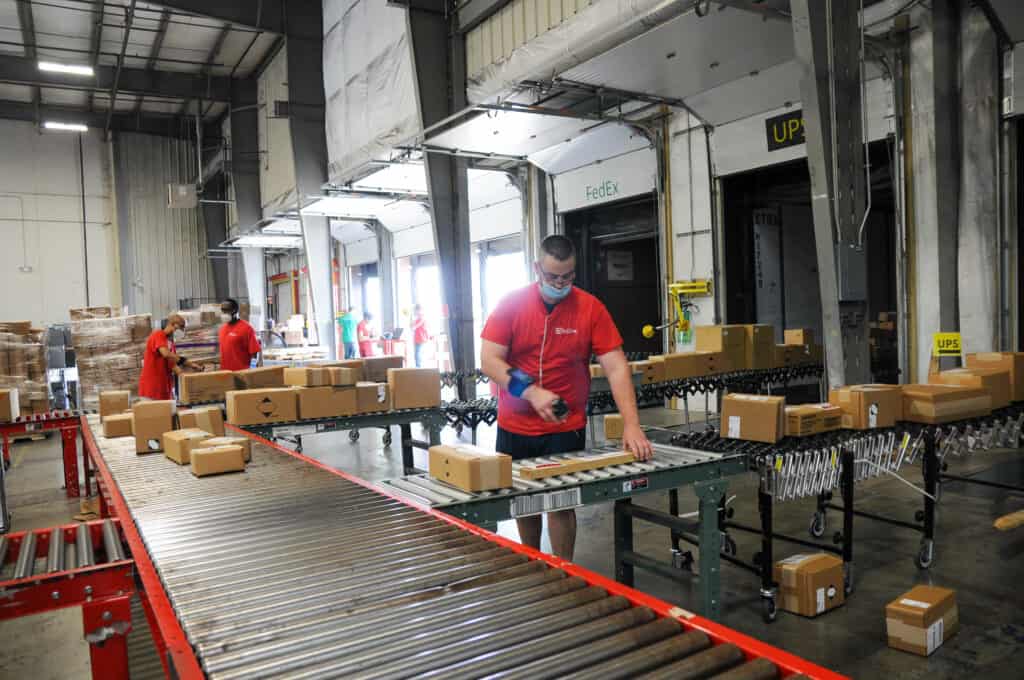The novel coronavirus pandemic has brought an influx of customers to online retail. Online sales were up 76% in June 2020 over 2019. That is good news for eCommerce businesses. However, many are facing challenges in dealing with returns during the pandemic.

In 2020, consumers have flocked to eCommerce websites as they have stayed away from retail shopping. In fact, eCommerce is expected to see an 18% increase this year, despite an overall projected 10.5% decline in retail sales.
Online sales are returned at about twice the rate of in-store purchases. ECommerce returns are a bit more complex than in-store returns at the best of times. To ship returns back, you have to find ways to seamlessly add your customers to your reverse logistics supply chain. Because of concerns about infection, eCommerce returns during the pandemic present additional problems.
COVID-19 challenges for eCommerce returns
COVID-19 has slowed down order fulfillment operations for many eCommerce businesses. Disruptions to supply chains during the initial outbreak have mostly been resolved. However, third-party logistics companies need to keep warehouse workers six feet apart and do extra cleaning. This can add days to both outbound and inbound fulfillment at your third-party logistics provider.
To respond to these challenges, online retailers have developed new policies for returns during the pandemic. These practices help keep both workers and customers safe.

Changes to returns during the pandemic
New effects of the COVID-19 pandemic on eCommerce continue to emerge. Here are just some of the changes that retailers have made so far to better handle returns during the pandemic.
Extended return times
Many online retailers have increased the time that consumers have to make returns during the pandemic. Extended return times make sense for merchants that operate both online and brick-and-mortar stores. The extra time gives customers the option to make returns in person. That choice will only make sense once they feel safe enough to go back into stores.
Allowing in-store returns benefits both consumers and retailers. Consumers prefer the convenience of dropping off returns at the store. That’s easier than packing and shipping items to send them back. And in-store returns save retailers money on return shipping. Plus, returns are a good excuse to bring customers into the store, where they may make another purchase.
Even businesses that only sell online may want to offer longer return windows. The pandemic has placed unique stresses on many consumers. The goodwill gesture of an extended returns window can give people the confidence to make an online purchase. Knowing that they’ll have plenty of time to complete a return will ease their fear about making a purchase.
It’s worth noting that extending the timeframe for returns during the pandemic does have downsides. A larger pool of potential returns can make inventory management more complex. This is where a 3PL can help you optimize inventory allocation. In addition, consumers expect merchants to continue extended return times even after the pandemic.
Suspension of buy online/return in store policies
Some retailers have stopped accepting eCommerce returns in their brick-and-mortar locations. Initially, this was because stores were closed. However, as retail locations have re-opened, this hybrid returns policy remains problematic.
Many retailers have instituted special procedures for handling returned items to prevent virus transmission. These safety protocols are easier to follow in a warehouse than in a retail setting. Therefore, some stores are requiring online returns for online purchases.
Caution in returns handling
It’s unlikely that you can catch coronavirus from a box. Still, many fulfillment warehouses have instituted new procedures to process returns during the pandemic. This can include quarantining returned packages for a day or more.
As far as we know right now, the virus may live on cardboard for up to 24 hours. Because of this, a quarantine ensures that packages are safe for warehouse staff to handle.
In addition, some retailers have changed their criteria for which returned items can be resold. They are moving more returns into the discard pile and putting fewer items back out for resale. During the pandemic, consumers are less willing to buy products that have been handled by other customers. Plus, the cost to clean some products for resale may outweigh the benefits of gaining another sale.

Consumer responses to returns during the pandemic
While consumers have gravitated toward online shopping over the past several months, they have some reservations. One big concern is returns. First-time eCommerce shoppers in particular may worry about returns during the pandemic.
Shoppers are less likely to buy when return policies are confusing or unclear. This is true in the best of times. It’s even more true for returns during the pandemic. One of the best things you can do to increase your sales is to make your returns process clear. It’s a good idea to communicate your policy at checkout or before.
Return rates during COVID
One of the biggest questions about eCommerce returns during the pandemic is the return rate. The average eCommerce return rate is 30%. The bump in online sales could affect that.
Changes to online retail due to the coronavirus are very new. We don’t yet have hard numbers on return rates during COVID. However, early signs point to slightly higher return rates. This could be because consumers aren’t able to touch items in stores before buying online. In addition, millions of people in the US have lost their jobs. Buyers who find themselves unemployed may choose to return purchases they can no longer afford.

Next challenge for returns during the pandemic: avoiding the holiday crush
The holidays are a busy time for eCommerce fulfillment. The holidays and the period right after are also a crunch for eCommerce returns. During this period, many warehouses hire more staff to handle the rush. However, employees need to be spaced out to stay healthy. To deal with this, online retailers are hoping to space out the holidays.
Many large retailers plan to start holiday sales before Halloween to give shoppers more time to buy gifts. It remains to be seen whether this will allow stores to have a profitable fourth quarter. At the very least, it might prevent a last-minute buying rush.
Amazon has changed its sales strategy, too. It has shifted Prime Day from July to October this year. Prime Day is the biggest sales day on the Amazon calendar.
Amazon’s fulfillment operations were initially swamped by increased demand due to the pandemic. It’s not clear whether this move is to allow them to catch up. The move could be based on the assumption that more people may be back at work and ready to shop by October.
If nothing else, an October Amazon Prime Day will give online retail a head start on the holidays. Since more holiday shopping will happen online, it makes sense to stretch out the holiday fulfillment window. This will also widen the window for returning unwanted purchases. And that will give welcome relief to businesses dealing with returns during the pandemic.




